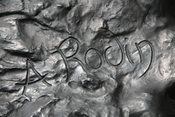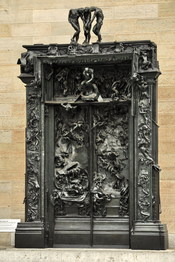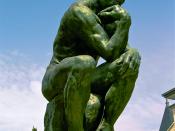"The Thinker is a larger than life-size bronze sculpture of a nude male figure sitting on rock. The figure sits hunched over leaning on his right palm and his left arm resting on his leg, hand clenched in a fist. The Thinker's body is immense, with bulging well defined musculature and fluid composition; he appears very strong and solid. The surface of the bronze is unrefined unlike the smoothness of Greek, Roman or classical sculptures but bares some of the same features. The figure, as the name suggests, sits in deep thought, his knuckles pressed against his mouth and brows lowered in concentration. There is a tension in the figure's body, as if he could suddenly rise and lift himself from the rock to embark upon whatever he was thinking about. Rodin created sculptures with similar materials, utilizing surface quality, interpretations of their own senses of naturalism and investigation of the human form as vehicles for expression.
Rodin's sculptures connect work from the Romantic 19th century to the 20th century's push toward Modernism. During a time when sculpture was apart of architecture design or used for decorative public dedication Rodin created sculpture as art itself. He took sculpture from this realm and placed it in an environment to be admired on its own. Rodin also departed from the style of classical posing of the figure for a more natural relaxed everyday pose, which resulted in accusations of casting directly from his models.
The original idea for "The Thinker" came from Dante's "The Divine Comedy". During the 19th century Europe rediscovered Art and Writing from the Middle Ages like Dante's Inferno from which the original concept for 'The Thinker" was derived. In 1880 Rodin was commissioned to create a set of bronze doors for a new museum...


